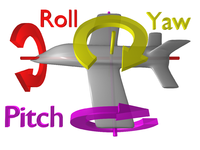因為牛頓力學之運動方程『形式』假設了『慣性觀察者』。即使無視『接近光速』的『特殊相對論』,所謂『三體問題』
Three-body problem
In physics and classical mechanics, the three-body problem is the problem of taking an initial set of data that specifies the positions, masses, and velocities of three bodies for some particular point in time and then determining the motions of the three bodies, in accordance with Newton’s laws of motion and of universal gravitation which are the laws of classical mechanics. The three-body problem is a special case of the n-body problem. Unlike two-body problems, there is no general closed-form solution for every condition, and numerical methods are needed to solve these problems.
Historically, the first specific three-body problem to receive extended study was the one involving the Moon, the Earth, and the Sun.[1] In an extended modern sense, a three-body problem is a class of problems in classical or quantum mechanics that models the motion of three particles.
尚且難得『數學確解』也!如何能說 ![]() 個『質點』之問題呢?
個『質點』之問題呢?
因此大千萬象、日常物體的『運動描述』豈非無望耶??
故而『理想假設』之興,求其近似,易於『計算推導』矣 !!
剛體運動學
在物理學裏,理想剛體是一種有限尺寸,可以忽略形變的固體。不論是否感受到外力,在剛體內部,點與點之間的距離都不會改變。根據相對論,這種物體不可能實際存在,但物體通常可以假定為完美剛體,前提是必須滿足運動速度超小於光速的條件。
剛體是由一群數量超多的質點組成。實際而言,不可能精確地追蹤其中每一個質點的運動。為了簡化運算,通常,整個剛體的空間位形可以簡易地以參數設定:
- 剛體的「位置」:挑選剛體內部一點 G 來代表整個剛體,通常會設定物體的質心或形心為這一點。從空間參考系 S 觀測,點 G 的位置就是整個剛體在空間的位置。位置可以應用向量的概念來表示:向量的起點為參考系 S 的原點,終點為點 G 。
- 剛體的取向:描述剛體取向的方法有好幾種,包括方向餘弦、歐拉角、四元數等等。這些方法設定一個附體參考系 B 的取向(相對於空間參考系 S )。附體參考系是固定於剛體的參考系 。相對於剛體,附體參考系的取向固定不變。由於剛體可能會呈加速度運動,所以附體參考系可能不是慣性參考系。空間參考系是某設定慣性參考系,例如,在觀測飛機的飛行運動時,附著於飛機場控制塔的參考系可以設定為空間參考系,而附著於飛機的參考系則可設定為附體參考系。
歐拉旋轉定理
歐拉旋轉定理表明,在三維空間裏,假設約束剛體內部一點固定不動,則其任意位移等價於繞著某固定軸的一個旋轉,而這固定軸必包含這固定點。換句話說,設定附體參考系 B 的原點為這固定點,則附體參考系 B 不會因為這位移而涉及任何平移運動,這位移等價於繞著某固定軸的一個旋轉。[2]
沙勒定理
當剛體移動時,它的位置與取向都可能會隨著時間演進而改變。沙勒定理是歐拉旋轉定理的一個推論。根據沙勒定理,剛體的最廣義位移等價於一個平移加上一個旋轉。[2]因此,剛體運動可分為平移運動與旋轉運動。剛體的現在位置與現在取向可以視為是從某個初始位置與初始取向經過平移與旋轉而成。
如右圖所示,從時間 ![]() 到時間
到時間 ![]() ,當剛體在做平移運動時,任意內部兩點,點 P 與點 Q 的軌跡(以黑色實線表示)相互平行,線段
,當剛體在做平移運動時,任意內部兩點,點 P 與點 Q 的軌跡(以黑色實線表示)相互平行,線段 ![]() (以黑色虛線表示)的方向保持恆定。
(以黑色虛線表示)的方向保持恆定。
挑選剛體內部一點 G 來代表整個剛體,設定附體參考系 B 的原點於點 G (稱為「基點」),則從空間參考系 S 觀測,在剛體內部任意一點 P 的位置 ![]() 為
為
![]() ;
;
其中,![]() 分別是基點 G 的位置、點 P 對於基點 G 的相對位置。
分別是基點 G 的位置、點 P 對於基點 G 的相對位置。
從附體參考系 B 觀測,剛體內部每一點的位置都固定不變,但從空間參考系 S 觀測,剛體從時間 ![]() 到時間
到時間 ![]() 的運動,可以分為基點 G 從
的運動,可以分為基點 G 從 ![]() 到
到 ![]() 的平移運動,與位移
的平移運動,與位移 ![]() 從時間
從時間 ![]() 到時間
到時間 ![]() 的旋轉運動。
的旋轉運動。
平移速度與角速度
從不同的參考系觀測剛體運動,可能會獲得不同的平移速度和不同的角速度。為了確保測量結果具有實際物理意義,必需先給定參考系。
剛體的平移速度是向量,是其位置向量的時間變化率,是附著於剛體的基點 G 的速度。對於純平移運動(沒有任何旋轉運動),剛體內部所有點的移動速度相同。假設涉及旋轉運動,則通常剛體內部任意兩點的瞬時速度不相等;只有當它們恰巧處於同一直軸,而這直軸平行於轉動瞬軸,則它們的瞬時速度相等。
角速度也是向量,描述剛體取向改變的角速率,和剛體旋轉時的瞬時轉軸的方向(歐拉旋轉定理保證瞬時轉軸的存在)。在任意時間,剛體內部每一個質點的角速度相同。
向量的時間變化率
假設一剛體呈純旋轉運動,旋轉的角速度為 ![]() ,其附體參考系 B 也會跟著旋轉,因此,對於任意向量
,其附體參考系 B 也會跟著旋轉,因此,對於任意向量 ![]() ,從這附體參考系 B 與從空間參考系 S 觀測,會得到不同的結果。設定
,從這附體參考系 B 與從空間參考系 S 觀測,會得到不同的結果。設定
![]() 、
、![]() 分別為從空間參考系 S 、附體參考系 B 觀測到的向量
分別為從空間參考系 S 、附體參考系 B 觀測到的向量 ![]() 對於時間的導數,則
對於時間的導數,則
![]() 。
。
項目 ![]() 可以想像為,從空間參考系 S 觀測,剛體內部位置向量為
可以想像為,從空間參考系 S 觀測,剛體內部位置向量為 ![]() 的質點,由於剛體旋轉而產生的角速度。
的質點,由於剛體旋轉而產生的角速度。
向量 ![]() 是任意向量,因此可以將
是任意向量,因此可以將 ![]() 、
、![]() 當作算符,這樣,對應的算符方程式的形式為:
當作算符,這樣,對應的算符方程式的形式為:
![]() 。
。
這算符方程式可以作用於任意含時向量。
運動學方程式
根據沙勒定理,剛體的最廣義位移等價於一個平移加上一個旋轉 。[2]挑選剛體內部一點 G 來代表整個剛體,設定附體參考系 B 的原點於基點 G ,則從空間參考系 S 觀測,在剛體內部任意一點 P 的位置 ![]() 為
為
![]() ;
;
其中,![]() 、
、 ![]() 分別是基點 G 的位置、點 P 對於基點 G 的相對位置。
分別是基點 G 的位置、點 P 對於基點 G 的相對位置。
點 P 的速度 ![]() 為
為
![]() ;
;
其中,![]() 、
、 ![]() 分別是基點 G 的速度、點 P 對於基點 G 的相對速度。
分別是基點 G 的速度、點 P 對於基點 G 的相對速度。
應用前段推導出的適用於任意含時向量的算符方程式,可以計算出 ![]() 。由於從附體參考系 B 觀測,剛體內部每一點的位置都固定不變,項目
。由於從附體參考系 B 觀測,剛體內部每一點的位置都固定不變,項目
![]() 等於零:
等於零:
![]() ;
;
其中,![]() 是剛體的角速度向量。
是剛體的角速度向量。
所以,點 P 的速度為
![]() 。
。
點 P 的加速度 ![]() 為
為
![]() ;
;
其中,![]() 、
、 ![]() 分別是基點 G 的加速度、點 P 對於基點 G 的相對加速度。
分別是基點 G 的加速度、點 P 對於基點 G 的相對加速度。
再應用前段推導出的算符方程式,可以計算出
![]() ;
;
其中,![]() 是附體參考系 B 旋轉的角加速度向量。
是附體參考系 B 旋轉的角加速度向量。
運動約束
「運動約束」指的是一個動態系統的運動必須符合的約束條件。以下列出一些例子:
純滾動
假若,一個圓柱形物體滾動於平面上,不做任何滑動運動(物體與平面之間,沒有任何滑動摩擦),則這物體的運動稱為「純滾動」,其質心的速度 ![]() 必須符合約束條件:
必須符合約束條件:
![]() ;
;
其中,![]() 是旋轉的角速度,
是旋轉的角速度,![]() 是從物體與平面的接觸點到物體質心的位移向量。
是從物體與平面的接觸點到物體質心的位移向量。
對於物體在滾動時不傾斜或不轉彎的案例,這約束條件約化為
![]() 。
。
無伸縮性繩子
當感受到張力的作用時,「無伸縮性繩子」不會因為張力的大小而改變繩子的長度。對於涉及無伸縮性繩子的物理問題,約束條件是繩子長度保持不變[5]。
- 單擺:將一根無伸縮性繩子的一端固定,另外一端繫住一個錘。這就形成了一個簡單擺。在基礎動力學裏,簡單擺問題研究錘的擺動運動跟繩子長度、錘重量之間的關係。
- 溜溜球:在兩片圓盤之間連結的捲軸,繫著一根無伸縮性繩子。這就是古今中外、廣為流行的溜溜球玩具。
- 懸鏈線:將無伸縮性繩子的兩端分別固定於兩點,由於均勻重力作用於繩子的每一部份而形成的曲線形狀稱為懸鏈線[6]。
那麼 SymPy 裡的
RigidBody
- class
sympy.physics.mechanics.rigidbody.RigidBody(name, masscenter, frame, mass, inertia) - An idealized rigid body.
This is essentially a container which holds the various components which describe a rigid body: a name, mass, center of mass, reference frame, and inertia.
All of these need to be supplied on creation, but can be changed afterwards.
Attributes
| name | (string) The body’s name. |
| masscenter | (Point) The point which represents the center of mass of the rigid body. |
| frame | (ReferenceFrame) The ReferenceFrame which the rigid body is fixed in. |
| mass | (Sympifyable) The body’s mass. |
| inertia | ((Dyadic, Point)) The body’s inertia about a point; stored in a tuple as shown above. |
『程式建制』能出其右乎!!??
誠如
簡介所言



單講『描述複雜』亦難矣哉??!!


